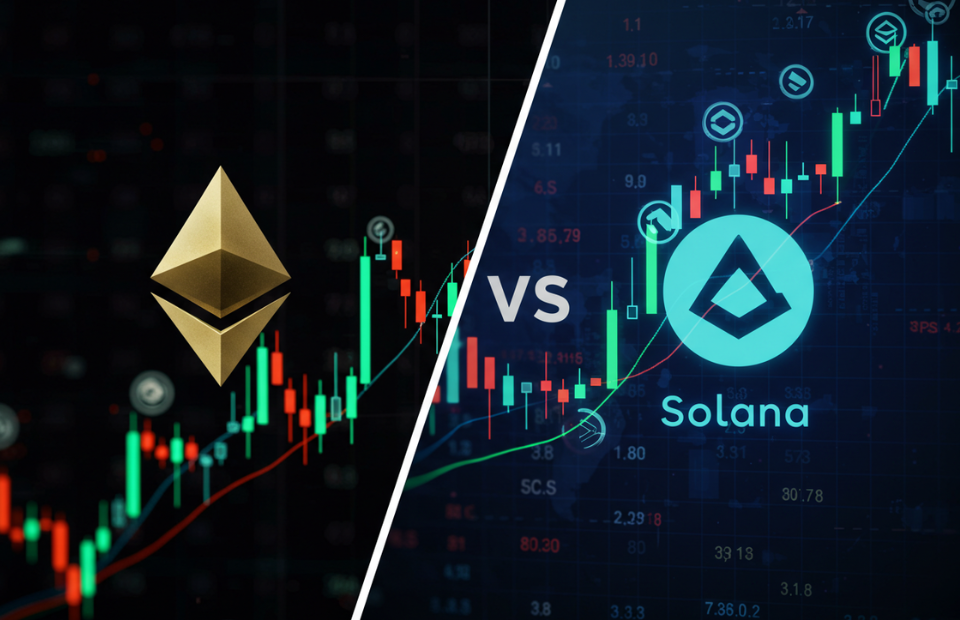Deciding whether to invest in Ethereum (ETH) or Solana (SOL) in 2025 is a tough call, as both are leading Layer-1 blockchains with unique strengths and risks. This guide breaks down their key differences, performance metrics, and investment potential to help you make an informed decision. Cryptocurrency investments are highly volatile, so always conduct your own research and consider your risk tolerance before investing.

Overview of Ethereum and Solana
- Ethereum: Launched in 2015, Ethereum is the pioneer of smart contracts and decentralized applications (dApps). It’s the second-largest cryptocurrency by market cap ($265-$390 billion in 2025) and dominates decentralized finance (DeFi) and non-fungible tokens (NFTs). Its transition to Proof-of-Stake (PoS) in 2022 improved energy efficiency, and upgrades like Dencun in 2024 aim to lower fees and boost scalability.
- Solana: Launched in 2020, Solana is a high-performance blockchain known for its speed and low costs, using a unique Proof-of-History (PoH) and PoS hybrid. It ranks in the top 5 by market cap ($75-$103 billion in 2025) and is gaining traction in DeFi, NFTs, and meme coins.
Key Comparisons
1. Performance and Scalability
- Ethereum: Processes ~15-30 transactions per second (TPS) with Layer-2 solutions boosting scalability. Gas fees, though reduced post-Dencun, range from $10-$50 during peak times, which can deter small transactions.
- Solana: Handles up to 65,000 TPS with sub-second confirmation and fees under a cent, making it ideal for high-frequency applications like gaming and decentralized exchanges (DEXs). The upcoming Firedancer upgrade could push TPS to 1 million.
Winner: Solana, for its superior speed and lower costs, especially for retail users and developers.
2. Ecosystem and Adoption
- Ethereum: Boasts the largest developer community (80% of blockchain developers per Electric Capital’s 2024 report) and hosts major DeFi protocols (e.g., Uniswap) and NFT marketplaces (e.g., OpenSea). Its $220.8 million revenue in Q1 2025 and $390 billion market cap reflect its dominance. Institutional adoption, like Ethereum ETFs in 2024, adds stability.
- Solana: Gaining ground with 7,625 new developers in 2024 (vs. Ethereum’s 6,456) and a rapidly growing ecosystem, including DEXs like Raydium and meme coin platforms like Pump.fun, which generated $575 million in fees since March 2024. Its $9.8 billion stablecoin market and $120.6 billion DEX volume in January 2025 show strong retail activity.
Winner: Ethereum, for its mature ecosystem and institutional backing, though Solana is catching up fast.
3. Security and Decentralization
- Ethereum: With over 1 million validators, Ethereum is highly decentralized and battle-tested, offering robust security. Its long track record makes it a trusted choice for developers and investors.
- Solana: Has ~4,500 validators, raising some concerns about centralization. Past outages (e.g., a 17-hour downtime in 2021) highlight risks, though network stability has improved in 2025.
Winner: Ethereum, for its stronger decentralization and proven security.
4. Price Performance and Market Trends
- Ethereum: From $2 in 2016 to ~$2,000-$3,150 in 2025, Ethereum has delivered a 1,000x return over a decade but is down 35% in 2025, with analysts predicting a 2025 range of $3,632-$4,416.
- Solana: Up 1,322% since January 2023, compared to Ethereum’s 81%. Despite a 50% drop from its January 2025 high of $294, SOL’s price is ~$168-$204, with some analysts forecasting a 3,000% rise by 2030 due to its “iPhone moment.”
Winner: Solana, for its stronger recent performance and growth potential, though it’s riskier.
5. Use Cases and Innovation
- Ethereum: Leads in DeFi, NFTs, and real-world asset (RWA) tokenization, with institutional players like BlackRock building on its network. Layer-2 solutions like Arbitrum enhance scalability.
- Solana: Excels in high-throughput applications like gaming, DeFi, and meme coins. Innovations like Pump.fun, the Solana Seeker smartphone (2025), and AI agent platforms are driving adoption.
Winner: Tie, as Ethereum dominates established use cases, while Solana leads in emerging, retail-driven applications.
Investment Considerations
Why Invest in Ethereum?
- Pros: Mature ecosystem, strong developer community, institutional support (e.g., ETFs), and proven security make it a safer long-term bet. Ideal for investors seeking stability and exposure to DeFi/NFTs.
- Cons: High fees and slower TPS limit retail usability. Recent price stagnation suggests lower short-term upside.
Why Invest in Solana?
- Pros: Lightning-fast transactions, low fees, and growing adoption in DeFi, gaming, and meme coins make it attractive for retail and developers. Strong price momentum and innovations like Firedancer signal high growth potential.
- Cons: Less decentralized, with past outages raising reliability concerns. Heavy meme coin exposure adds speculative risk.
Risks to Consider
- Market Volatility: Both cryptocurrencies are highly volatile. Solana’s 50% drop from its 2025 peak and Ethereum’s 35% YTD decline highlight risks.
- Regulatory Uncertainty: While Ethereum ETFs are approved, Solana ETF applications are pending in the U.S., which could impact prices.
- Competition: Other Layer-1 blockchains (e.g., Cardano, Polygon) could challenge both.
Which Should You Invest In?
- Choose Ethereum if you prioritize stability, institutional backing, and a proven track record. It’s ideal for long-term investors comfortable with slower growth but lower risk.
- Choose Solana if you’re willing to take on higher risk for potentially higher rewards. Its speed, low fees, and retail-driven growth make it appealing for those betting on emerging trends like meme coins or gaming.
- Diversify: Given their complementary strengths, consider investing in both to balance Ethereum’s stability with Solana’s growth potential.
Conclusion
Ethereum remains the safer, more established choice with a robust ecosystem, while Solana offers compelling growth opportunities with its speed and innovation. Your decision depends on your goals: Ethereum for long-term reliability, Solana for high-risk, high-reward potential. Always diversify, research thoroughly, and only invest what you can afford to lose. For more on Ethereum, visit ethereum.org. For Solana, check solana.com.
Disclaimer: Cryptocurrency investments carry significant risks. Past performance doesn’t guarantee future results. Consult a financial advisor before investing.


![Bitcoin Bounces Back Above \$[Price]: Is This a Bull Trap? Bitcoin Bounces Back Above \$[Price]: Is This a Bull Trap?](https://aullaba.com/wp-content/uploads/2025/06/bitcoin-bounces-back-above-price-is-this-a-bull-trap.png)